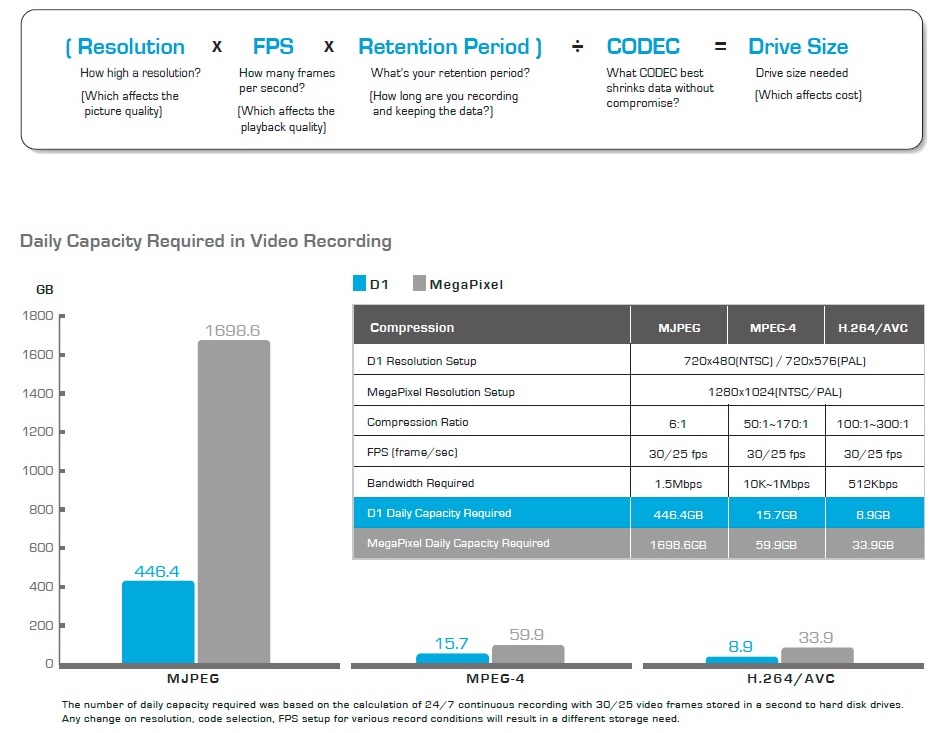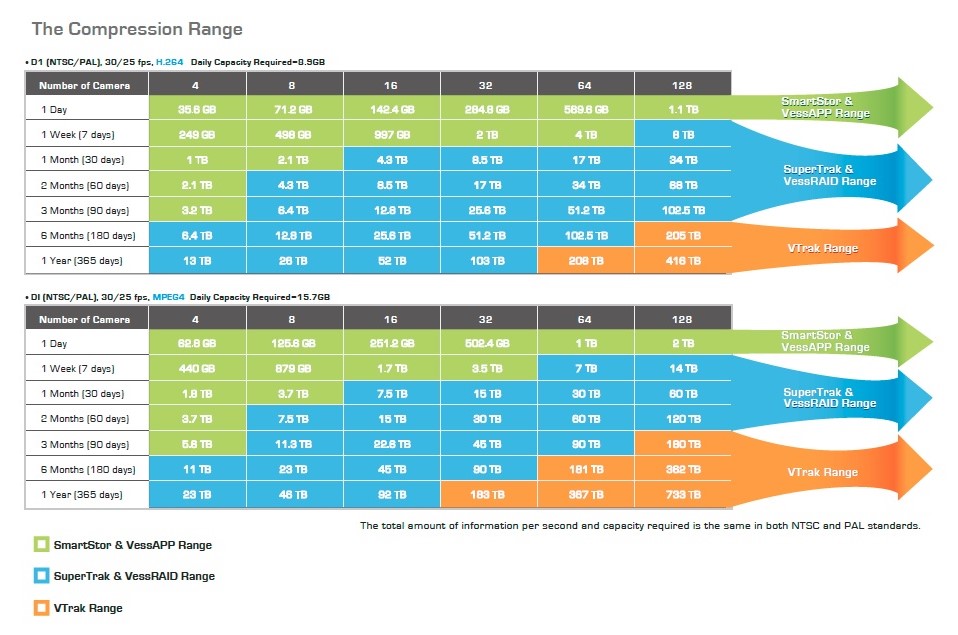Related Products:
Vess A6120 Series - Vess A2000 Series - Vess R2600fi - VTrak Series
E Series
PROMISE’s RAID products can promise you all-in-one flexible storage with failsafe protection that can handle continuous streaming input without file drop under live conditions.
HOW MUCH STORAGE?
A number of factors drive frame size change. But when it comes to the calculation of how much capacity required for managing data, there are several factors to be taken into account. These are:
 Allowing users to transfer high quality data using a lower bit rate bandwidth, modern compression technology offers more quality for less cost. And it’s sophistication is advancing daily. MJPEG has the lowest compression ratio, but is the only submittal compression standard accepted. MPEG-4 is the market leader in analogue recording technologies. But H.264, an advanced video compression standard known as MPEG-4 part10, is expected to dominate future codec implementation.
Allowing users to transfer high quality data using a lower bit rate bandwidth, modern compression technology offers more quality for less cost. And it’s sophistication is advancing daily. MJPEG has the lowest compression ratio, but is the only submittal compression standard accepted. MPEG-4 is the market leader in analogue recording technologies. But H.264, an advanced video compression standard known as MPEG-4 part10, is expected to dominate future codec implementation.
Of course some less obvious factors such as time, lighting level, quality setting, the motion detection algorithm, and the types of scene will also impact the size of the archive. These, nevertheless, are minor factors. So, let’s move on and look at how to examine your data deployment scale and pick right storage arrays.
DEPLOYMENT SCALE
In data deployment, there are two basic factors that determine the size of system needed. There are the number of sorces needed and the amount of transfering time needed. System sizes come in three basic entirely scalable ranges: small, midrange and large. Since most technologies are typically embedded with one to two hard drives by default, the need of using external storage arrays is reliant on the two factors mentioned above. Using a 720 x 480p resolution with 30 frame-per-second rate produces around 31MBs of data per second, meaning that from one system we can obtain a whopping 2.6 TBs of uncompressed capacity in a straight 24-hour non-stop operation. And thanks to modern CODECs, we can reduce the size significantly to either accommodate more systems or keep a longer retention period. The Compression Range chart illustrates the correlation between the number of systems installed and the resultant retention period while using the H.264 and MPEG-4 compression format.

From The Compression Range chart without taking into account retention period, if you want to record continuously for more than thirty days on a 16-system setup using a DVR or , even with two default drives installed giving a maximum of 4TB available space for archiving, after that period you’re going to need external storage. If a four-system setup has to keep six months data safe for security requirements, we still can’t categorize it as a small, midsize or large range. Although usually video data preservation periods vary depending on different locations and security levels, in our notes we’ll take one month to be the leading indicator to identify the deployment scale because a thirty days storage seems to be video standard practice.
Therefore, for entry video applications we can define one to sixteen systems to be the typical number needed depending on budget and the required recording characteristics. This package fits homes, retail shops, laundry stores, family clinics and restaurants requiring entry level video installation. In the midrange set-ups with 16 to 256 systems tend to be performance driven from a storage perspective. A decent storage bandwidth allows concurrent video input from various locations and enables users to gain a better stability during live and playback controls. Large scale installations of over 256 systems usually require performance features such as real-time multi-thread recording and rate scalability that can extend capacity on an ad hoc basis. Also, here systems are generating data in volume so quickly that the ability and flexibility to provide immediate capacity expansion is also vital.
DAS, NAS, OR SAN?
Small Range Solutions
How do you pick the right storage architecture at the entry level? You need a layout that requires instant or remote access to the archive, and plug and play convenience. A direct or network attached storage system ranging from two to four bays is the ideal choice. These utilize USB, eSATA, and Gigabit Ethernet connectivity, are simple to install and require a minimum of support. See our SmartStor & VessAPP range for more details.
Midsize Range Solutions
Midsized arrangements with 16 to 256 systems have to cope with a number of concurrent video streams in seconds. This means that sufficient connecting bandwidth is the first priority when choosing storage. Speed is essential to avoid hitting a live playback bottleneck. So whatever choice is finally made, performance is the key and a SCSI or SAS interfaced DAS storage, or an iSCSI SAN lock-up will provide a better throughput guarantee for all types of applications at this level. Please see our SuperTrak, VessRAID and VTrak ranges for more details.
Large Range Solutions
Large-scale installations, such as public transportation sites, city , and worldwide organizations, require expansion flexibility, trustworthy reliability, cost-effectiveness, centralized storage management and onsite vendor support. Our VessRAID and VTrak ranges can handle data from hundreds or even thousands of systems. Storage here means being able to provide a lot of drive spaces for recording, support on-demand expansion while extending the retention period, offer reliable and high throughput for immediate read and write access, and solve any unexpected technical glitches in real time, because video downtime is unacceptable in high-level security environments. Under such circumstances, DAS storage, either SCSI or SAS, and a trunked iSCSI or FC SAN architecture with huge expansion capabilities, is the only solution.
MAPPING PROMISE SOLUTIONS
Increased video data means a growing demand for storage. With the right storage you can safeguard days or months of video records operating on optimal drive utilization that combines
maximum cost efficiency and security effectiveness. With our distinguished technical expertise in the storage industry and extensive experience in video , PROMISE promises to help you find the perfect storage solution for your customers. To build the perfect storage solution for various video environments, please follow the "How to Start" chart to quickly find the most suitable products for your deployment.
There are so many storage products available in the market that it can be confusing. The Q&A Flow Chart aims at giving installers a convenient guide to quickly and easily select the best storage solution from PROMISE. For example, if you’re a regional integrator looking for a new video portfolio that includes storage capable of fitting in a retail shop needing eight IP-based systems, you’ll find that the SmartStor NAS series immediately pops up as the best choice. Or if you have a midsized installation using purely analog systems that requires a simple extension of the retention period in response to local governing laws, you’ll see that the VTrak and VessRAID SAS series are the options.
Comprehensive Product Coverage for Video
PROMISE Technology has designed and manufactured sophisticated RAID solutions for more than 20 years. Catering to small, midsize, and large scale data requirements, our profound knowledge and dedication means that we can produce storage requirements for all levels of need. For entry level users we can provide comprehensive storage solutions, including NAS and DAS appliances for 1 to 16 system installation bases. For SMBs, we offer host-based RAID controllers for internal and external disk drive connections from 16 to 64 systems. And for large scale enterprises we can deploy high available standalone RAID subsystems for more than thousands of networked systems. As such integrators and installers who want to have a single
umbrella storage solution able to streamline a control of Audio and video data management, PROMISE can promise to meet all your needs.